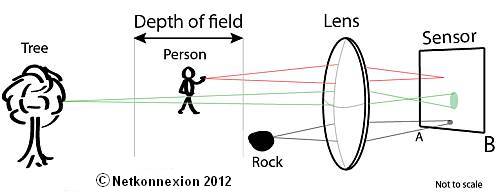![]()
Circle of Confusion

The diagram is not to scale.
Diagram showing the various sizes of a Circle of Confusion. Only a point of light from inside the depth of field forms a sharp point to our eyes. As we get to the edge of the depth of field the tiny points of light become less focused. The individual points are called the circle of confusion (CoC).
Tiny points of light – the Circle of Confusion
A lens cannot resolve a point of light exactly. Instead, it creates a tiny circle of light called the ‘Circle of Confusion’ or CoC. At the best point of focus for a lens (the object plane), our eye sees a tiny point of light as a well focused point.
However, away from the object plane the points of light gradually become less sharp. Our eyes cannot immediately detect this tiny loss of sharpness. To us, the point still looks focused. However, the circle of confusion enlarges the further away a point lies from the object plane.
At some point, further away from the object plane, the CoC gets big enough for our eyes to detect it. To us, it is no longer acceptably sharp. When we can detect the circle of confusion, the image is ‘unsharp’. Here, each point of light has become unsharp the image is going out of focus.
The ‘Circle of Confusion’ defines the ‘Depth of Field’
When our eyes detect an individual point of light as unsharp this defines the edge of the ‘Depth of Field‘ (DoF). Inside the DoF any individual point of light is acceptably sharp to our eyes. Outside of the DoF we detect the circle of confusion and the subject goes out of focus.
Outside the DoF the focus is poor. Instead of focusing almost exactly on the sensor plane, the focus falls short. This is like the tree in the diagram above. The CoC for each point of light can be seen by the eye – they overlap giving an out of focus point in the image.
Alternatively, the focus point is beyond the sensor. Our example is the rock in the diagram. Here, the circle of confusion creates a larger circle on the sensor. These points on the subject(s), the tree and rock, appear out of focus because circles of confusion representing individual points on the subject overlap each other.
Let’s take a walk
Here is how it works… As our person in the diagram walks from the object plane, nearer to the edge of the depth of field, the circle of confusion will gradually grow. At some point the person passes the DoF edge. Now, all the circles of confusion that make up the person’s image are large enough for us to see. The focus is lost. The point we are observing has become unsharp. So, the image will become more blurred as the subject continues to walk toward the lens. In other words, as our person walks out of the DoF we see the circle of confusion overlapping with other points nearby. This creates a blurred area of the image.
Circle of confusion – size matters
Size is the critical factor. An ‘acceptably sharp’ CoC is defined as one that appears sharp to the eye on an 203 × 254 mm (8 x 10 inch) print viewed from 305 mm (12 inches) away. In practice this works out to about 0.25 mm (1/100th of an inch) on that print size. Of course a different standard size would apply to different print sizes. Manufactures use these standards to create DoF markers for lenses.
In the modern digital camera we already have a standard preset for the circle of confusion on the sensor. In practice the individual pixel on the sensor makes a convenient focus-point definition. If an individual point of light creates a circle of confusion bigger than the size of one pixel, it will start to affect the surrounding pixels and the sharpness will be lost.
Depth of Field (A Glossary entry).
Definition: Bokeh. (About the blur in the out-of-focus area).
Circle of confusion on Wikipedia [More technical – detailed formulae included]

Damon Guy (Netkonnexion)
See also: Editors ‘Bio’.
See also: Profile on Google+.
